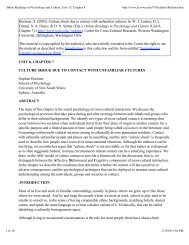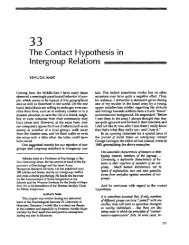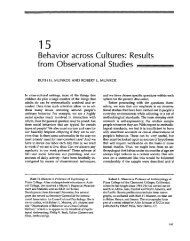Malpass - Eyewitness Identification Lab
Malpass - Eyewitness Identification Lab
Malpass - Eyewitness Identification Lab
Create successful ePaper yourself
Turn your PDF publications into a flip-book with our unique Google optimized e-Paper software.
12 Psychology and Law, Overview<br />
ENCYCLOPEDIA OF APPLIED PSYCHOLOGY - APSY 00380<br />
p0330<br />
p0335<br />
jurors at the conclusion of the trial are typically confidential,<br />
and the observation or recording of jury<br />
deliberations in many jurisdictions is prohibited. This<br />
policy has impeded researchers from gathering much<br />
information about the scope of jury-initiated misconduct<br />
in actual trials. Researchers who rely on post-trial<br />
interviews can not accurately gauge the extent to<br />
which juror recall is accurate and reliable. At times,<br />
researchers have employed ‘‘shadow jurors’’ who attend<br />
courtroom trials and then are interviewed about<br />
their observations to infer what the actual jurors might<br />
think of the evidence. Occasionally, extra alternate<br />
jurors have been empanelled and their deliberations<br />
have been videotaped and analyzed to gain insight<br />
into how the information they heard and witnessed is<br />
used in reaching a verdict.<br />
Research involving real jurors in actual cases,<br />
including archival studies of jury verdicts, is relatively<br />
rare, accounting for approximately 10% of the jury<br />
studies conducted over an 18-year period. Because<br />
this method is not very informative about the decision-making<br />
process of the jury, many researchers<br />
have adopted a mock trial paradigm in which simulated<br />
juries receive information akin to that presented<br />
in an actual case. The materials may range in realism<br />
from brief written descriptions or case summaries to<br />
extensive videotaped trials in which attorneys present<br />
opening and closing arguments and question witnesses<br />
via direct and cross-examination, and jury<br />
instructions on the law are provided to the mock<br />
jurors. A benefit of this approach is the more extensive<br />
empirical control gained by the researcher, permitting<br />
causal inferences to be drawn. When mock<br />
jurors are used, the extent to which they are similar<br />
to actual or potential jurors is an issue. Although<br />
much of this research has been conducted with psychology<br />
undergraduates, the use of jury-eligible participants<br />
has steadily increased, enhancing the<br />
generalizability of these results.<br />
The unit of analysis studies by jury researchers has<br />
varied. In some cases, individual jurors are the target<br />
of the studies, while in others, group deliberations<br />
are included, and the unit of analysis is the jury. The<br />
article by Albertson, Farley, and Hans carefully outlines<br />
the major findings to emerge from both types of<br />
studies, i.e., those that have focused on individual<br />
jurors and those that have addressed the jury as a<br />
group. Studies of the deliberation process have<br />
increased in the past 30 years, and they have examined<br />
the influence of features such as the size of the<br />
jury, the way in which differences of opinion<br />
between majority and minority groups are resolved,<br />
the influence of majority versus unanimity rules, and<br />
so forth.<br />
The significance of distinctions between external<br />
validity and ecological validity have been highlighted<br />
by Bornstein (1999) and Vidmar (2004), specifically in<br />
discussing whether research conditions in simulation<br />
studies include sufficient features of real trials to render<br />
them adequately representative of actual trials,<br />
permitting researchers to draw on research findings<br />
to make policy recommendations regarding reforms<br />
to enhance jury performance. Questions of normative<br />
criteria against which jury performance should be<br />
assessed have also been raised, particularly since research<br />
has shown that many judges are susceptible to<br />
the same biases or weaknesses as are many jurors. The<br />
authors suggested that profitable future avenues of<br />
research might include the influence of juror and jury<br />
anonymity, options for jurors to become more active<br />
during the trial, and comparative jury studies.<br />
See Also the Following Articles<br />
Intra-refs to be added.<br />
Further Reading<br />
Bausermann, R. (2002). Child adjustment in joint custody<br />
versus sole custody arrangements: A meta-analytic review.<br />
Journal of Family Psychology, 16, 91–102.<br />
Bornstein, B. (1999). The ecological validity of jury simulations:<br />
Is the jury still out Law and Human Behavior, 23,<br />
75–91.<br />
Costanzo, M. (2004). Psychology applied to law. Belmont, CA:<br />
Wadsworth/Thompson.<br />
Devine, D. J., Clayton, L. D., Dunford, B. B., Seying, R., &<br />
Pryce, J. (2001). Jury decision making: 45 years of empirical<br />
research on deliberating groups. Psychology, Public<br />
Policy, and Law, 7, 622–727.<br />
Finkel, N. J. (1995). Commonsense justice: Jurors’ notions of<br />
the law. Cambridge, MA: Harvard University Press.<br />
Fisher, R. P. (1995). Interviewing victims and witnesses of<br />
crime. Psychology, Public Policy and Law, 4, 732–764.<br />
Fisher, R., & Quigley, K. L. (1992). Applying cognitive theory<br />
in public health investigations: enhancing food recall with<br />
the cognitive interview. In Tanur, J. M. (Ed.), Questions<br />
about questions: Inquiries into the cognitive bases of surveys.<br />
New York: Russell Sage 154–169.<br />
Foote, W. E., & Goodman-Delahunty, J. (2004). Evaluating<br />
sexual harassment: Psychological, social, and legal considerations<br />
in forensic examinations. Washington, DC:<br />
American Psychological Association.<br />
ELSEVIER PROOF<br />
p0340<br />
p0345







